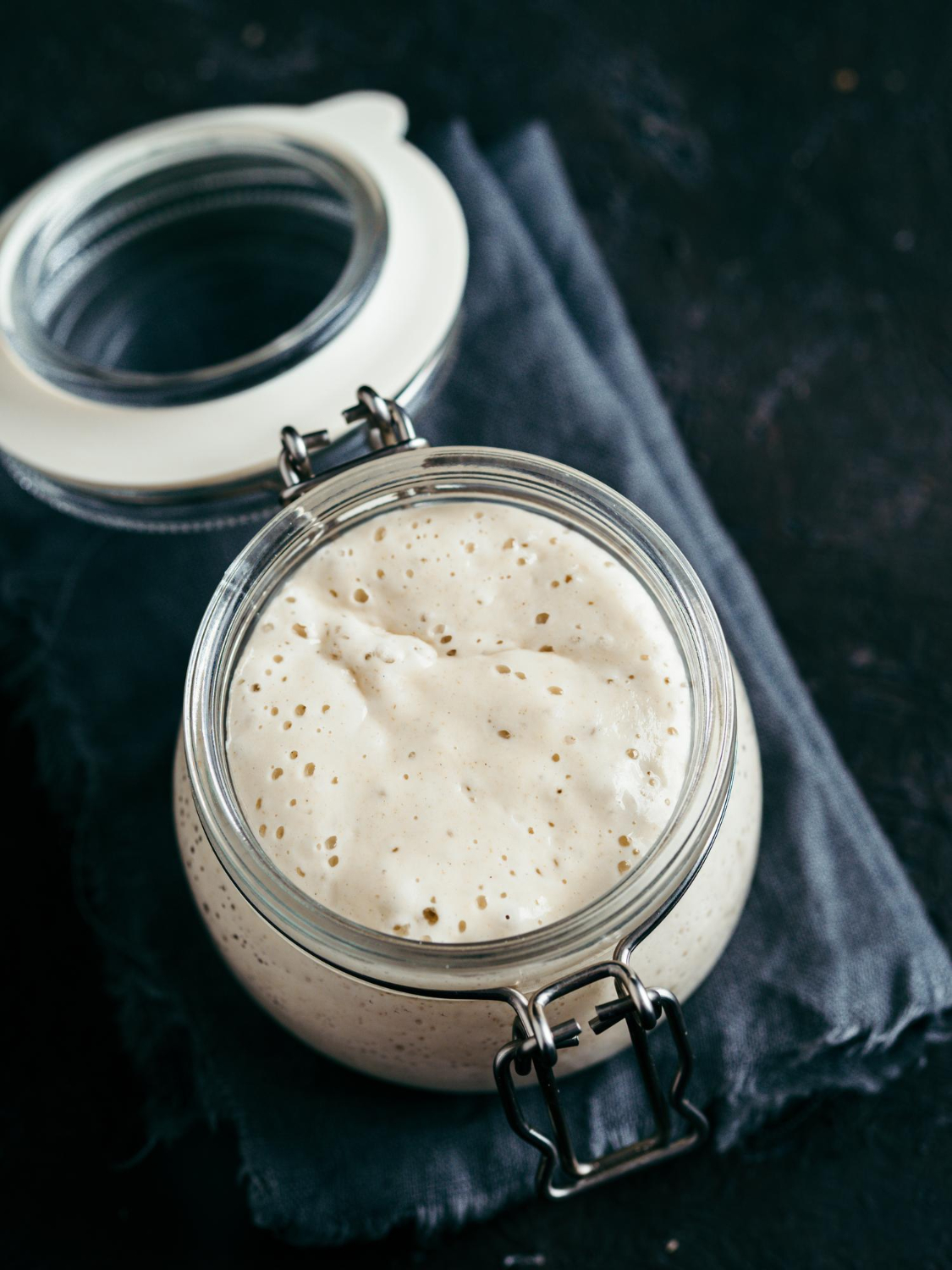How to Store Sourdough Starter: Room Temperature vs Refrigerator
Your healthy sourdough starter needs the right balance of storage conditions and temperature. Most bakers at home find it tricky to balance between room temperature and refrigerator storage. These storage methods affect your starter’s activity and feeding schedule by a lot. The right storage approach will give a consistent result and helps you avoid common problems.
Counter storage versus refrigeration comes down to a few things that matter – how often you bake, the room’s warmth, and how mature your starter is. When you keep it at room temperature, your starter stays active and ready to use. The refrigerator works great if you don’t bake too often. This piece gets into both storage methods, the best temperature ranges that work for fermentation, and the quickest way to keep your starter happy all year round.
Room Temperature Storage
Your sourdough starter thrives at room temperature. This environment creates ideal conditions for regular fermentation. Proper storage and maintenance are significant factors that ensure consistent bread-making results. active sourdough starter
Ideal temperature range
Your sourdough starter needs temperatures between 70°F to 82°F (21°C to 28°C) to thrive. These temperatures create perfect conditions for healthy fermentation and keep beneficial bacteria active. The starter works best at a steady 72°F and can double or triple its size in about eight hours.
| Temperature Range | Starter Activity |
|---|---|
| Below 70°F (21°C) | Slower fermentation |
| 70-75°F (21-24°C) | Moderate activity |
| 75-82°F (24-28°C) | Peak performance |
Feeding frequency
The feeding schedule is significant to your starter’s health and vitality at room temperature. A mature starter needs:
- Daily feeding in cooler environments (around 70°F)
- Twice-daily feeding in warmer conditions or for maximum activity
- 12-hour intervals between feedings to get optimal results
The ambient temperature associates with how often you need to feed your starter. Higher temperatures speed up fermentation, which means more frequent feeding is necessary. Young starters need extra care and twice-daily feeding to stop mold from growing and keep proper pH levels.
Benefits and drawbacks
Room temperature storage gives active bakers several advantages. Your starter stays ready to use and you retain control over fermentation activity that delivers predictable results. Bakers can watch their starter’s behavior up close and learn its unique patterns.
This method comes with its own set of challenges. You’ll need to feed your starter more often, which uses extra flour and creates waste. The starter’s stability can change with the seasons and shifting temperatures. It also needs a strict feeding schedule that might not work with everyone’s daily routine.
Your starter needs careful monitoring to get the best results. A healthy starter at room temperature should bubble consistently and give off a pleasant sour smell. You can expect regular rising patterns too. The right temperature makes all the difference – any sudden changes will stress your culture and affect how well it performs.
Refrigerator Storage
Bakers without daily baking routines can use refrigerator storage to keep their sourdough starter healthy. This storage method substantially reduces the maintenance needed and keeps the starter viable longer.
Slowing down fermentation
Cold temperatures make fermentation almost stop by forcing the starter into dormancy. The yeast becomes mostly inactive when temperatures reach 3°C (37°F). Beneficial bacteria keep working but at much slower rates. This cold-induced dormancy brings several benefits:
- You need less flour
- Your starter needs fewer feedings
- The sour flavor develops more
- You can take vacations without worry
- The maintenance becomes easier
Starters with lower hydration perform better in the refrigerator. They show better strength during long cold storage compared to liquid starters.
Feeding schedule
Refrigerated starters need substantially less maintenance than their room-temperature counterparts. Here’s a detailed feeding timeline:
| Storage Duration | Feeding Requirements | Starter Condition |
|---|---|---|
| 1-2 weeks | One feeding | Optimal activity |
| 2-3 weeks | May need revival | Slightly sluggish |
| 3+ weeks | Multiple feedings needed | Extended recovery |
Bakers should feed their starter with equal parts flour and water before refrigeration. The starter’s container needs a seal that prevents moisture loss but allows some gas exchange. Weekly feeding works best, and a mature starter can survive several weeks without food. A gray liquid layer called hooch might appear on top, showing the starter needs feeding.
Reactivating refrigerated starter
You need patience and proper technique to revive a refrigerated starter before baking. The revival process works best with these steps:
- Remove starter from refrigerator and let warm for 1 hour
- Transfer 20-25g to a clean container
- Feed with 50g each of flour and water
- Allow 12 hours at room temperature
- Repeat feeding process if needed
- Verify readiness through doubling test
Your starter should double in size and show a slightly domed top with bubbles throughout. This indicates proper reactivation. Starters kept in the fridge more than two weeks might need extra feeding cycles. A small amount of whole-grain rye flour in the first feeding can boost activity.
Your starter’s ability to survive cold storage depends on its maturity and health before refrigeration. Young starters should not be refrigerated until they show consistent, strong fermentation. Cold storage can slow down their development by a lot. Mature starters handle long refrigeration periods well and bounce back quickly.
Methods to Keep Starter Warm
Temperature control is crucial for a healthy sourdough starter, especially when you have cold weather or air-conditioned spaces. You can use several quick ways to create the right warmth that your starter needs for proper fermentation and activity.
Oven with light on
Your oven light creates a perfect warm environment that helps develop sourdough starter. The temperature stays steady between 75-80°F (24-27°C), which makes fermentation consistent. But bakers need to be careful:
- Keep starter away from direct light
- Check temperature regularly
- Put up a clear warning sign so no one turns on the oven
- Take out starter before heating the oven
Important Note: Switch off the light after 30-60 minutes. The starter can get too warm if left under the light too long.
Warm water bath
A warm water bath lets you control temperature with gentle, consistent warming. This method works especially well in winter when temperatures drop by a lot. The optimal setup has:
| Component | Specification |
|---|---|
| Water Temperature | 85-90°F (29-32°C) |
| Container Height | 2-3 inches of water |
| Monitoring Frequency | Every 4-6 hours |
| Water Change | When temperature drops below 80°F |
Place the starter container in a larger vessel with warm water to get the best results. Keep the water level below the starter jar’s lid to avoid contamination.
Seed raising mat
Seed raising mats offer an excellent way to keep temperatures consistent, especially during cold weather. These specialized mats create gentle bottom heat that provides an ideal environment for seedling growth. The advantages include:
- Consistent temperature maintenance
- Space-efficient setup
- Budget-friendly long-term solution
- Easy temperature monitoring
A thin towel should be placed between the mat and starter container to prevent direct contact and ensure even heat distribution. This setup works best with a temperature controller that enables precise regulation.
Yogurt maker
A yogurt maker is the quickest way to keep your sourdough starter at the right temperature. These devices keep temperatures between 70-90°F (21-32°C), which works perfectly for starter development. Here’s what makes them great:
- Precise temperature control
- Built-in timing functions
- Protection from direct sunlight
- Consistent environment
Temperature Management: Your yogurt maker’s temperature usually stays around 86°F (30°C). This temperature boosts lactobacillus activity and creates a stronger sour flavor with active fermentation. You should adjust the timing to avoid overfermentation during regular maintenance.
Your home’s environment, available equipment, and how much control you want will help determine the best warming method. Each approach has its advantages. Many bakers mix different methods to get the best results as seasons change or conditions shift.
Choosing the Best Storage Method
You need to think about several factors when choosing a storage method for your sourdough starter. A good storage choice will give you consistent results. The method should fit your lifestyle as a baker and work well with your environmental conditions.
Baking frequency
Your sourdough baking schedule plays a key role in picking the right storage method. Bakers need to think about their routine before choosing between room temperature and refrigerated storage:
| Baking Frequency | Recommended Storage | Maintenance Level |
|---|---|---|
| Daily to Bi-weekly | Room Temperature | High (Daily feeding) |
| Weekly | Hybrid Approach | Moderate |
| Monthly or Less | Refrigeration | Low (Weekly feeding) |
| Extended Break | Dehydration | Minimal |
Hybrid Approach: Many bakers keep a small amount at room temperature to use regularly and store a backup portion in the fridge. This method offers flexibility and makes sure you always have starter ready.
Climate considerations
Weather patterns affect how you store your sourdough starter. Your starter’s health and fermentation speed change with temperature and humidity levels:
Warm Climates (Above 75°F/24°C):
- Your starter needs refrigeration
- Room temperature storage needs more frequent feeds
- A temperature-controlled environment works best
- Keep track of humidity levels
Cold Climates (Below 65°F/18°C):
- Your starter might need extra warmth at room temperature
- Fermentation takes longer
- Refrigeration gives more stable results
- Extra insulation helps protect your starter
Seasons change and your storage methods should too. Bakers who deal with changing weather often mix different storage methods based on the current conditions.
Starter maturity
A sourdough starter’s age and stability affect how you should store it by a lot. Two-month old starters are more resilient and adapt better to storage conditions of all types.
Young Starters (Less than 2 weeks old):
- Need room temperature storage at all times
- Must stick to regular feeding times
- React strongly to environment changes
- Storage options remain limited until they’re 2 weeks old
Mature Starters (2+ months old):
- Deal with temperature changes easily
- Do great in the fridge
- Spring back to life quickly after dormancy
- Work well with any long-term storage method
Your starter’s maturity level determines how fast it bounces back after storage. Mature starters usually come back to life after one or two feedings. Young cultures need extra care to reach full strength again.
Here’s what you should think about when picking a storage container:
- Size: Your starter needs space to grow (2-3 times its size)
- Material: Glass or food-grade ceramic works best
- Shape: Straight sides make cleaning easier
- Closure: A loose lid lets gasses escape
- Transparency: Clear containers help you watch your starter
Temperature control is a vital part of successful long-term storage. Professional bakers often keep separate fridges at 42-50°F (5.5-10°C) just for their starters. This temperature sweet spot slows fermentation but keeps the good bacteria alive.
Storage periods longer than three weeks need special care:
- Make a backup dried starter
- Keep several small portions
- Use spaces with controlled temperature
- Set up a rotation system
Your storage method should match your schedule and your starter’s needs. A solid storage plan will give you consistent results and less maintenance work while keeping your starter healthy.
Conclusion
Sourdough starter maintenance success depends on picking the right storage method that fits your situation and needs. Room temperature storage works best for people who bake often. It delivers peak fermentation activity and consistent results. Refrigeration is a practical choice for occasional bakers since it needs less maintenance. Temperature control is crucial whatever method you choose. Proper monitoring and adjustments ensure the best bacterial activity and fermentation rates. Your climate, baking frequency, and starter maturity will shape these storage choices that are the foundations of reliable sourdough performance.
The right storage method guides you toward better baking results. You’ll get consistent flavors and perfect fermentation every time. Good storage conditions prevent common problems and keep your starter healthy longer. Ready to get amazing results? You can lift your bread and pizza game with an authentic artisanal sourdough starter from The Yeast We Can Do. This premium starter is the perfect foundation for exceptional bread and pizza with that signature tangy flavor and perfect crust. Email john@the yeastwecando.com to get yours. Smart storage choices and proper maintenance techniques ensure your starter performs reliably and delivers quality results every time you bake.
FAQs
Should I keep my sourdough starter at room temperature or in the fridge?
Ideally, your sourdough starter should be at room temperature before you mix it into your dough. Using it directly from the fridge can significantly delay the time it takes for the dough to ferment and come to room temperature.
What is the optimal way to store a sourdough starter?
The best practice is to store your sourdough starter in a container with a lid that is large enough to accommodate triple its volume after feeding. This allows the starter ample space to expand. Additionally, a container with a wide opening is beneficial for easy stirring.
Is it possible to leave sourdough starter unrefrigerated?
Yes, you can keep sourdough starter unrefrigerated. However, this requires daily feeding due to the influence of various factors like flour type and ambient temperature.
Should sourdough be proofed in the fridge or at room temperature?
Proofing sourdough in the fridge can enhance the crust’s appearance, making it darker and glossier with a more pronounced blistered texture. Although room temperature proofing alters the flavor, it does not spoil the sourdough.
How should I store my sourdough starter if I plan to bake infrequently?
For those who bake less often, perhaps biweekly or less, it’s advisable to store the sourdough starter in the refrigerator. After feeding the starter, you can place it directly in the fridge. When you’re ready to use it, take it out the night before, allow it to reach room temperature, and then feed it again before use. This method reduces the need for daily commitment to fee






